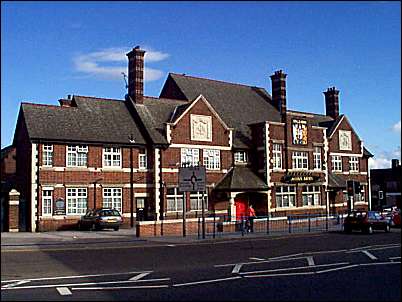The Kings Arms
at Meir has a bit of a lurid past. "I'm told that years ago its
reputation was pretty bad," says licensee Hilary Windsor, "But it's okay
now. Older customers recall fights going back years when the police had to
turn out in force. But it was a popular pub. They say the landlord could
take up to £20,000 a week just in drinks."
It's an assertion supported by former Meir policeman Roy Matthias.
"I've heard say that one licensee would line up a hundred pints of
beer on the bars before opening the doors on a Sunday dinnertime. That's
going some," says Roy
And yet it's such a striking building you can only wonder how it got
its bad reputation. The outside of the 1935 pub is pretentious to the
point of being extreme, with deep-sloping multi-gabled roofs and high
chimneys in a muddled blend of Art Deco utilitarian and hollow Gothic
architecture. At the back, an acre of land stretches south incorporating a
full-size bowling green.

Kings Arms - Meir
Weston Road - on corner of Uttoxeter Road (A50)
Hilary is delighted to show me her castle, with
room after room of oak-panelled luxury, through chambers that are so wide
they stand comparison with the finest hotels. "Come upstairs," says
Hilary, unlocking a dusty room filled with fabulous junk piled on a broken
billiard table. "They tell me Ray Reardon used to play competitions here.
It was his favourite snooker venue because it was so big." The best
features of the two big bar rooms are the oak-carved fireplaces. It's hard
to believe the stories of drunkenness and debauchery associated with the
place.
"It is a shame because it really is a tremendous pub," says Roy
Matthias. I began my career in the late 1940s and even then there were
gangs who'd converge on the Kings Arms.
"I guess it was because of its location as a crossroads and as an
outpost where several communities met. There was Coalville Estate, which
was then part of Leek. Half a mile south along Uttoxeter Road was policed
by Blythe Bridge, and Meir itself by Longton. Over three decades ding-dong
bloody tribal battles were the norm at weekends. And there was no proper
police station except for the front room of Sergeant Frank Sheppard's
house by Penfleet Avenue on Weston Road."
David Bradley, aged 72, born in Meir, had never set foot in the
pub until we were invited in by Hilary
"Goodness, you can see how impressive it is from the outside but I
never knew the extent of the interior furnishings," he gasps. "Just look
at the fabulous carvings and the wide staircase. It really is superb."
For the first 20 years of David's life, an equally impressive house in
Weston Road was home.
"You could see all along the railway to Blythe Bridge from the front
garden," he recalls. "When my father and uncle wanted to travel into
Longton they'd watch the train leave Blythe Bridge station and simply walk
down to Meir Station in time to catch it. It saved hanging around on the
platform."
|
Historian Steve Birks is fascinated by
Meir's location. "It was always known as a gateway into
Stoke-on-Trent," he says. "It straddles a main Roman road from
Rocester to Chesterton and at this point forms a crossroads with an
old lane from Leek to Stone.
"In 1087 the Domesday Book records Normacot, Weston and Caverswall
centring on Meir, which was located on the boundary of the Pirehill
and Totmonslow Hundreds. By the 13th century most of this land was
owned by the monks at Abbey Hulton who by the grace of
Henry Audley were important landowners."
Times change, but Meir maintains its control over
the entrance to the Potteries. "Apart from being a turnpike road, a
tunnel was dug beneath it to take the main train line from Crewe to
Derby," adds Steve. "There was also an attempt to build an
international airport here, but the aerodrome closed in 1973." |
Back in the bar of the Kings Arms, the regulars are discussing
old Meir. "Something important must have changed its course in the 1930s,"
says one local. "The roads were widened, old slums and pubs knocked down
and new properties built. The Broadway Cinema was really impressive."

The Broadway Cinema - Meir
Before its reckless demolition in 1971, the double-columned Art Deco
picture palace had stood distinctively on Sandon Road corner. According to
cinema historian Barry Blaize, the Broadway opened in 1936 with seating
for more than a thousand. "I did my courting there," says David Bradley.
"I wasn't particularly interested in what was showing rather than it had
double seats constructed especially for couples."
It seems that great things were being planned for Meir in the 1930s.
"New industry arrived," says another Kings Arms regular. "Rootes
factory manufacturing aircraft parts; Indesit, Creda, Simplex all came and
went. The council built new housing estates and added to them after the
war.
They say pubs and churches point to the power of a place.
The Kings Arms certainly demonstrates this, for above the grand
fireplace in the bar is an oak-carved shield commemorating the Noble Order
of the Queen's Garter with its famous motto - Honi Soit qui Mai y Pense,
which roughly means 'evil is he who thinks evil'.
You just never know in wild outposts like Meir.